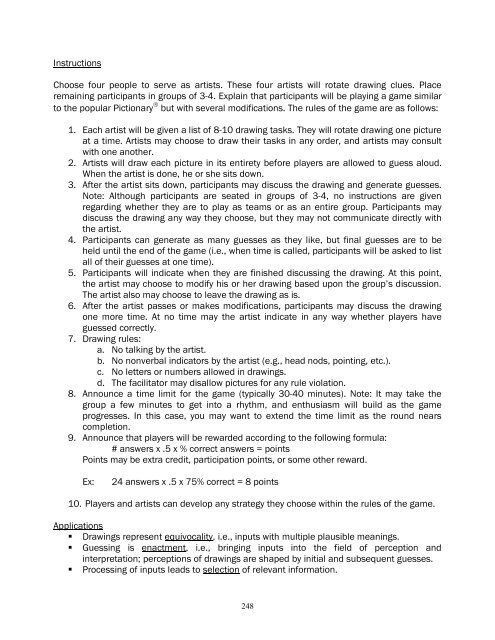Chapter 19.pdf
Chapter 19.pdf
Chapter 19.pdf
You also want an ePaper? Increase the reach of your titles
YUMPU automatically turns print PDFs into web optimized ePapers that Google loves.
Instructions<br />
Choose four people to serve as artists. These four artists will rotate drawing clues. Place<br />
remaining participants in groups of 3-4. Explain that participants will be playing a game similar<br />
to the popular Pictionary ® but with several modifications. The rules of the game are as follows:<br />
1. Each artist will be given a list of 8-10 drawing tasks. They will rotate drawing one picture<br />
at a time. Artists may choose to draw their tasks in any order, and artists may consult<br />
with one another.<br />
2. Artists will draw each picture in its entirety before players are allowed to guess aloud.<br />
When the artist is done, he or she sits down.<br />
3. After the artist sits down, participants may discuss the drawing and generate guesses.<br />
Note: Although participants are seated in groups of 3-4, no instructions are given<br />
regarding whether they are to play as teams or as an entire group. Participants may<br />
discuss the drawing any way they choose, but they may not communicate directly with<br />
the artist.<br />
4. Participants can generate as many guesses as they like, but final guesses are to be<br />
held until the end of the game (i.e., when time is called, participants will be asked to list<br />
all of their guesses at one time).<br />
5. Participants will indicate when they are finished discussing the drawing. At this point,<br />
the artist may choose to modify his or her drawing based upon the group’s discussion.<br />
The artist also may choose to leave the drawing as is.<br />
6. After the artist passes or makes modifications, participants may discuss the drawing<br />
one more time. At no time may the artist indicate in any way whether players have<br />
guessed correctly.<br />
7. Drawing rules:<br />
a. No talking by the artist.<br />
b. No nonverbal indicators by the artist (e.g., head nods, pointing, etc.).<br />
c. No letters or numbers allowed in drawings.<br />
d. The facilitator may disallow pictures for any rule violation.<br />
8. Announce a time limit for the game (typically 30-40 minutes). Note: It may take the<br />
group a few minutes to get into a rhythm, and enthusiasm will build as the game<br />
progresses. In this case, you may want to extend the time limit as the round nears<br />
completion.<br />
9. Announce that players will be rewarded according to the following formula:<br />
# answers x .5 x % correct answers = points<br />
Points may be extra credit, participation points, or some other reward.<br />
Ex: 24 answers x .5 x 75% correct = 8 points<br />
10. Players and artists can develop any strategy they choose within the rules of the game.<br />
Applications<br />
Drawings represent equivocality, i.e., inputs with multiple plausible meanings.<br />
Guessing is enactment, i.e., bringing inputs into the field of perception and<br />
interpretation; perceptions of drawings are shaped by initial and subsequent guesses.<br />
Processing of inputs leads to selection of relevant information.<br />
248


